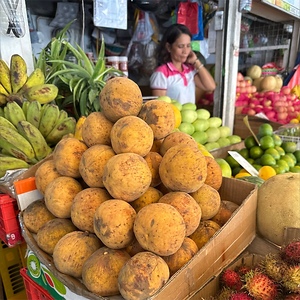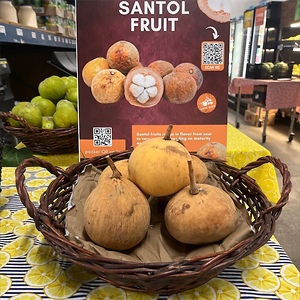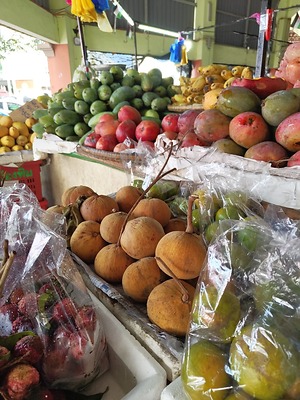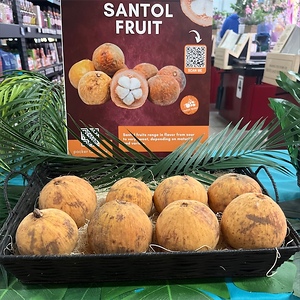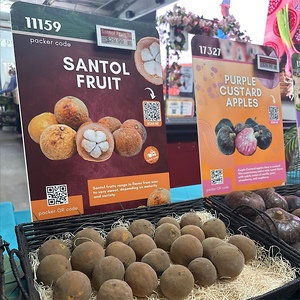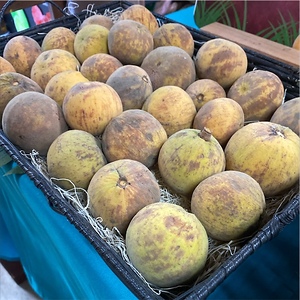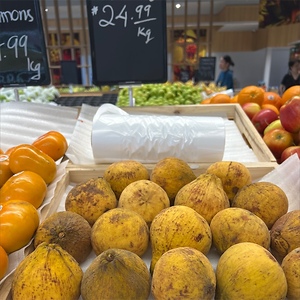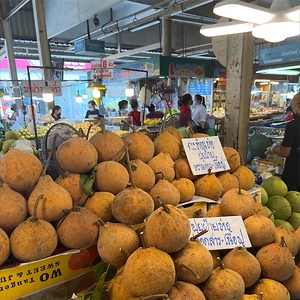

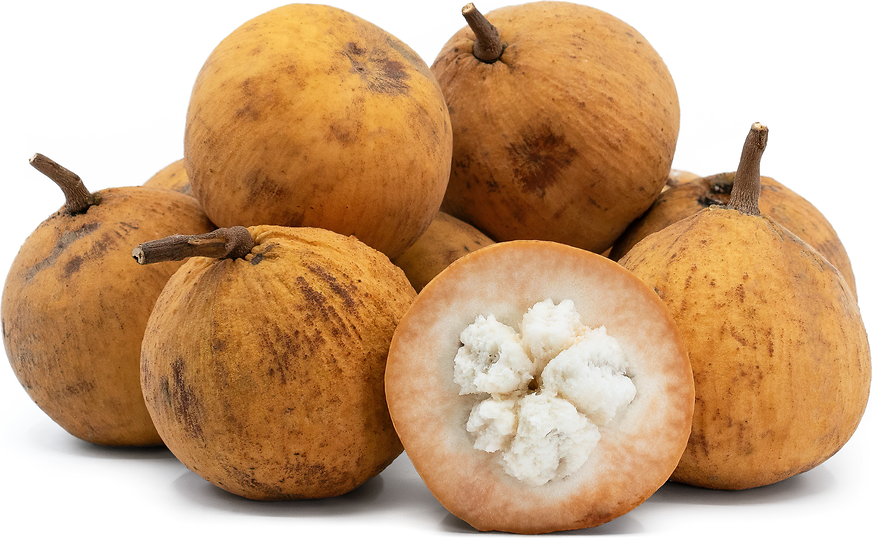
Santol Fruit
Estimated Inventory, lb : 0
This item was last sold on : 07/05/24
Description/Taste
Santol fruits vary in size and shape, depending on the variety, and generally average 4 to 7 centimeters in diameter with a round, oval, or oblate shape. The fruit’s surface is textured, semi-rough, leathery, tough, and wrinkled, ranging from thin to thick. Some Santol varieties may have a light layer of downy fuzz enveloping the surface, and the fruit’s skin ripens from green to shades of golden yellow to brown-yellow with a red-pink blush. A dry, spongy, and slightly fibrous rind underneath the surface encases five segments of white pulp and seeds. The rind matches the coloring of the fruit’s exterior, and the white flesh is soft, tender, aqueous, and cotton-like. Inside each segment, a large inedible seed around two centimeters in length is tightly adhered to the flesh. Some Santol cultivars may also contain milky juice, while others are dryer and lighter in consistency. Santol fruits are edible raw when ripe, and the rind and flesh are eaten. The fruit’s flavor ranges from sour to sweet, depending on the variety and maturity, and the flesh is typically sweet, tart, and tangy with candy-like, peach, apple, and citrus nuances. The rind has a sharper, more sour taste with subtle vegetal, green undertones.
Seasons/Availability
Santol fruits are available year-round at varying times in subtropical to tropical climates. They generally appear in markets throughout Southeast Asia from March through October.
Current Facts
Santol, botanically classified as Sandoricum koetjape, is the name of tropical to subtropical fruits belonging to the Meliaceae or Mahogany family. Several varieties of Santol fruits are found in markets worldwide, with most of the fruits grown and sold in Southeast Asia. Each variety varies in size, shape, coloring, and flavor, and the species is often divided into red or yellow types. Red Santol is regarded as the most common type sold commercially. Santol fruits develop on fast-growing trees that produce 19,000 to 24,000 fruits annually. The fruits are picked by hand or are yanked from the tree with a long stick and are sold in commercial markets for medicinal and culinary purposes. Santol fruits are also known as the Cotton fruit, Kechapi, Sentul, Kelampu, Katon, Santor, Sayai, Sentieh, and Ketjape. Consumers favor Santol fruits for their fragrant pulp, sour rind, and ability to be incorporated into raw or cooked preparations. The fruits are anticipated culinary items and are expanding in popularity as they are being introduced worldwide. Along with the fruits, the trees are valued for their ornamental nature in home gardens and as a durable wood for construction.
Nutritional Value
Santol fruits are a source of iron that develops the protein hemoglobin for oxygen transport through the bloodstream, fiber that regulates the digestive tract, and vitamin C that strengthens the immune system. The fruits also contain calcium to build bones and teeth, phosphorus to repair tissues, potassium to balance fluid levels within the body, magnesium to control nerve functioning, and other nutrients, including vitamin B and folate. In natural medicines, the roots, fruits, leaves, and bark are used in remedies to assist with digestive issues, infections, skin conditions, and allergies. The fruits are believed to help reduce inflammation within the body. It is important to note that the seeds are large, inedible, and should never be swallowed. There have been reports of people who accidentally ingested the seeds and experienced intestinal obstruction, requiring abdominal surgery to extract the seeds.
Applications
Santol fruits have a sweet, sour, and tangy taste suited for fresh or cooked preparations. The fruit’s rind and flesh are edible, while the skin and seeds are not and should be discarded. Santol fruits should be washed, and the tough skin can be broken open by applying pressure with your hands or cutting it with a knife. Once opened, the rind can be sliced away from the skin, and the flesh segments can be individually removed. It is challenging to separate the seeds from the flesh, so most consumers suck the flesh from the hard seed. The seed must not be swallowed. The rind is popularly dipped in salt and is eaten as a sour snack. Santol fruit flesh is primarily eaten out of hand but can also be soaked in fruit juices and blended into a beverage. In addition to fresh preparations, Santol fruit flesh can be simmered into jams, jellies, and syrups, canned for extended use, or candied as a topping over desserts. A fruit-infused syrup is popularly drizzled over baked goods, breakfast dishes, or ice cream as a sweet, tropical treat. The rind is used as a souring agent in savory dishes and is commonly added to sauces, soups, and curries. In the Philippines, Santol rind is grated and cooked in coconut milk with pork in a dish called sinantolan. It is also added to a fish broth known as sinigang na bangus. In Thailand, Santol is used to make som tam, a sweet, spicy, and sour dish. The fruits are typically not fully ripe and are also cooked into Thai curries. Santol fruits pair well with coconut, citrus, lemon, lime, aromatics such as garlic, onions, and ginger, sugar, tamarind, fish, and other meats, including beef, pork, and poultry. Whole, unwashed Santol fruits should be immediately consumed for the best quality and flavor. The fruits can be left at room temperature for a few days and will last longer in the refrigerator.
Ethnic/Cultural Info
Santol trees are rumored to be home to a mythical spirit known as the pugot in the Ilocos region of the Philippines. Legend has it that the pugot is a headless, nocturnal spirit and is a type of engkanto, a spirit that resides in nature. Pugot roughly translates to mean the “decapitated one” and is a creature that can take the form of a human, dog, or pig. The spirit is fond of Santol trees and often appears as a giant, black, headless being to people who pass by the trees at night. There are many tales associated with the pugot, the most famous being Tulid Nimputul, a myth from the province of Ifugao in the Philippines. In the myth, the pugot helps the protagonist of the tale. The pugot still appears in Filipino folklore in the modern day and is considered a harmless spirit.
Geography/History
Santol fruits are believed to be native to Southeast Asia and have been growing wild since ancient times. The species was thought to have arisen out of Cambodia, Southern Laos, Vietnam, and West Malaysia, and over time, the tropical fruits were carried into Thailand, Indonesia, India, the Philippines, and other neighboring countries. The species quickly naturalized in these regions, and the fruits were gathered from wild trees as a food source. Santol was eventually chosen for commercial production, and growers began breeding new varieties with improved cultivation traits to increase sales. Santol fruits are spread worldwide as a specialty crop, but most populations outside of Asia are very small. Today, Santol fruit trees thrive in tropical to subtropical lowlands and often grow in forests and along river banks. The species has also become a prevalent home garden tree planted in backyards, urban landscapes, and community gardens. When in season, Santol fruit is foraged from wild and cultivated plants and sold through fresh local markets, distributors, and select retailers.
Recipe Ideas
Recipes that include Santol Fruit. One
| Lifestyle Inquirer |
|
Prawns with Coconut Milk and Santol |
| The Peach Kitchen |
|
Santol Juice |



